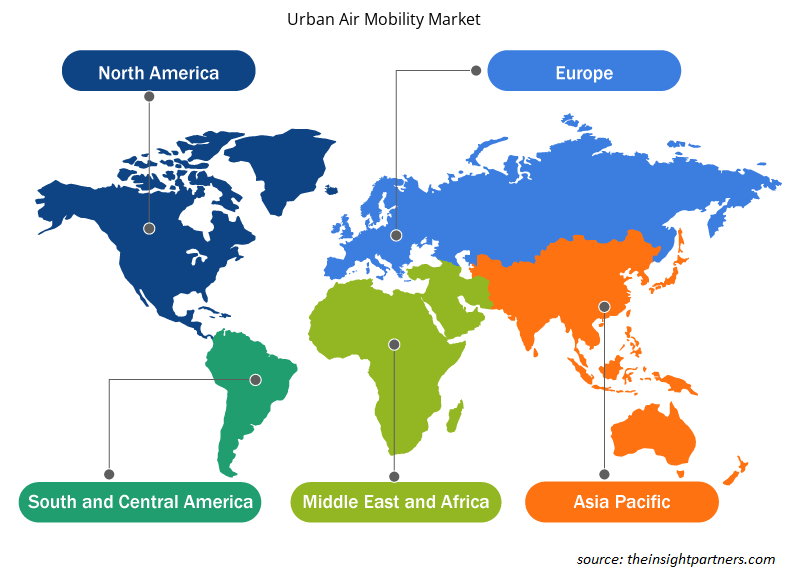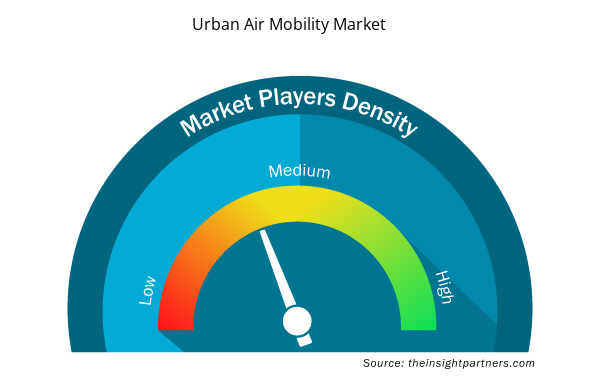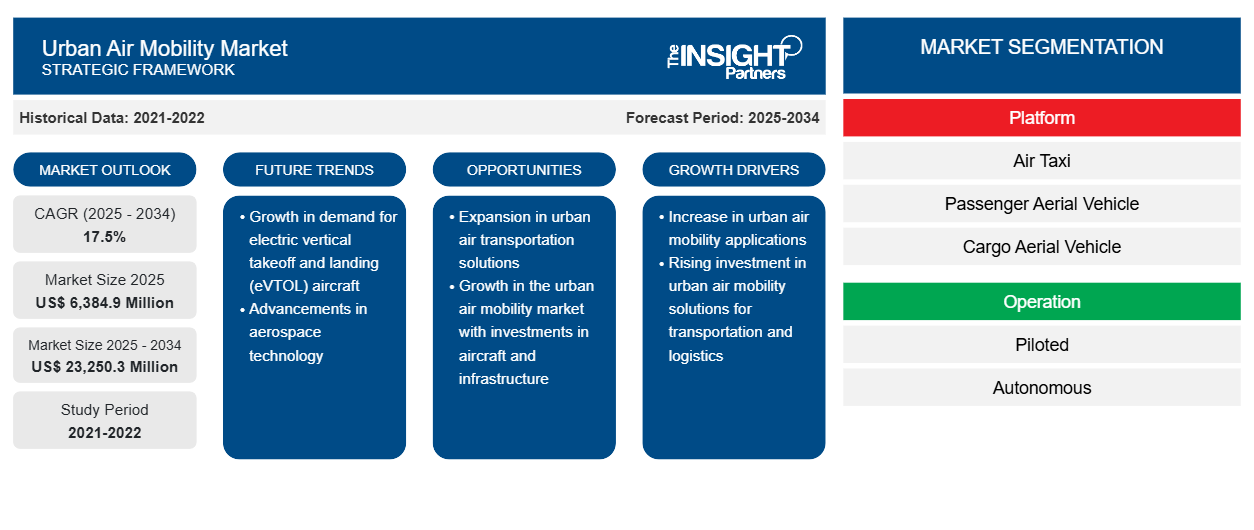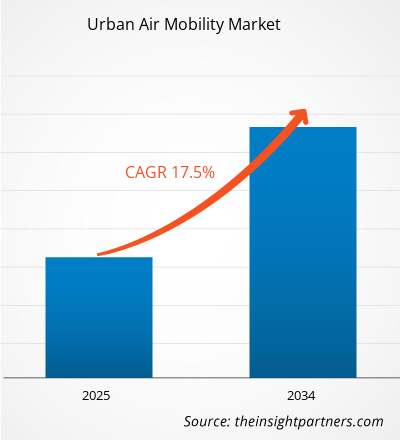都市航空モビリティ市場は、2025年に63億8,490万米ドルに達すると予想され、2034年までに232億5,030万米ドルに達すると予測されています。都市航空モビリティ市場は、2025年から2034年の予測期間中に17.5%のCAGRで成長すると予想されています。
都市部のエアモビリティ旅客キャリアでは、最低3人、最大5~6人の乗客が移動できます。地方では、必要に応じて6人以上の乗客が三輪の旅客キャリアで移動します。都市部の交通渋滞の増加は、市場の成長を促進する主な要因です。世界の都市人口が増加するにつれて、交通渋滞は人々の生活の質に深刻な影響を及ぼし、一般的な経済成長に打撃を与えています。たとえば、INRIX(交通分析会社)によると、米国の通勤者は、混雑のピーク時に毎年約41時間を交通渋滞に費やしています。また、2017年の交通渋滞により、米国のドライバーはおよそ3,050億米ドルの費用がかかり、ドライバー1人あたり平均1,445米ドルの損失を被ったと述べています。さらに、米国環境保護庁は、平均的な乗用車が毎年4.7トンの二酸化炭素を排出すると推定しています。さらに、インドや中国などの発展途上国では自動車の所有率が増加するとともに、自動車事故も急増しています。世界保健機関(WHO)によると、毎年およそ125万人が自動車事故で亡くなっており、1日当たりの死者数は約3,400人に達します。これには、致命的ではない事故で負傷する数百万の人は含まれていません。
世界の都市航空モビリティ市場は、旅客輸送と貨物輸送にタイプ別に分類されています。燃料タイプに基づいて、都市航空モビリティ市場はディーゼル、ガソリン、CNG、LPG、電気に分類されています。電気都市航空モビリティの需要の増加、人口の増加、および地域の交通渋滞を緩和する車両のニーズの増加により、世界の都市航空モビリティ市場の成長が促進されています。
要件に合わせてレポートをカスタマイズする
このレポートの一部、国レベルの分析、Excelデータパックなど、あらゆるレポートを無料でカスタマイズできます。また、スタートアップや大学向けのお得なオファーや割引もご利用いただけます。
- このレポートの主要な市場動向を入手してください。この無料サンプルには、市場動向から見積もりや予測に至るまでのデータ分析が含まれます。
都市航空モビリティ市場洞察
航空および自動運転技術の進歩
航空技術の進歩により、大都市圏の人々や貨物に便利で効率的なオンデマンド輸送を提供できる可能性が生まれています。都市航空モビリティ (UAM) は、社会の移動性を再構築する可能性を秘めた輸送コンセプトです。これは、非常に手頃でアクセスしやすく、高速な都市航空輸送を提案しており、既存の道路輸送インフラの負荷を軽減することで地上の混雑を緩和します。UAM は、分散型電気推進などの技術の向上、アプリケーションベースのライドシェアなどの新しいビジネスモデル、生産コストを削減する高度な航空宇宙製造のトレンドに依存しています。車両の自動化と自律車両操作の信用を高めることは、自律型 UAM ビジョンの実現に不可欠です。予想される高い需要に対応できる経済的に実行可能な輸送システムには、自律性が必要です。安定性と機動性に優れた垂直離着陸 (VTOL) 車両の技術的成熟度が大幅に向上し、高度に自動化された飛行が、主に UAM 業界を推進します。
プラットフォームベースの市場分析
都市の航空モビリティ市場は、プラットフォームに基づいて、エアタクシー、乗客用航空機、貨物用航空機、航空救急車に分かれています。UAM には、貨物や人間の簡単かつ迅速な輸送を可能にする幅広い用途があります。これらの UAM は、小物、医療製品の輸送に広く利用されており、乗客の輸送にも使用されます。ただし、これらのモビリティ ソリューションには、使用方法に応じて独自の飛行制限があります。UAM 車両は、中規模および高層ビルに衝突する可能性があるため低距離での飛行は許可されておらず、航空会社に衝突する可能性があるため高距離での飛行も許可されていません。
オペレーションベースの市場洞察
都市航空モビリティ市場は、運用方法に基づいて有人型と自律型に分かれています。自律型 eVTOL は貨物や乗客の輸送に適しており、都市間輸送での利用が拡大すると予想されるため、予測期間中は自律型セグメントが市場をリードすると予想されます。
都市航空モビリティ市場で事業を展開する企業は、市場イニシアチブ、買収、製品発売などの戦略に注力し、都市航空モビリティ市場での地位を維持しています。都市航空モビリティ市場の主要企業による開発の一部を以下に示します。
2020年2月、エアバスとシンガポール民間航空局は、シンガポールの都市部での航空移動を可能にするためのMOUを締結しました。この協力により、同国における都市部での航空移動が可能になります。
2019年2月、Airspace Experience TechnologiesはSpirit AeroSystemsと、認定された全電動垂直離着陸(eVTOL)航空機の開発について正式契約を締結しました。
都市型航空モビリティ市場の地域別分析
予測期間を通じて都市航空モビリティ市場に影響を与える地域的な傾向と要因は、Insight Partners のアナリストによって徹底的に説明されています。このセクションでは、北米、ヨーロッパ、アジア太平洋、中東、アフリカ、南米、中米にわたる都市航空モビリティ市場のセグメントと地理についても説明します。

- 都市航空モビリティ市場の地域別データを入手
都市航空モビリティ市場レポートの範囲
| レポート属性 | 詳細 |
|---|---|
| 2025年の市場規模 | 63億8,490万米ドル |
| 2034年までの市場規模 | 232億5,030万米ドル |
| 世界のCAGR(2025年~2034年) | 17.5% |
| 履歴データ | 2021-2022 |
| 予測期間 | 2025-2034 |
| 対象セグメント | プラットフォーム別
|
| 対象地域と国 | 北米
|
| 市場リーダーと主要企業プロフィール |
|
都市航空モビリティ市場のプレーヤーの密度:ビジネスダイナミクスへの影響を理解する
都市型航空モビリティ市場は、消費者の嗜好の変化、技術の進歩、製品の利点に対する認識の高まりなどの要因により、エンドユーザーの需要が高まり、急速に成長しています。需要が高まるにつれて、企業は提供を拡大し、消費者のニーズを満たすために革新し、新たなトレンドを活用し、市場の成長をさらに促進しています。
市場プレーヤー密度とは、特定の市場または業界内で活動している企業または会社の分布を指します。これは、特定の市場スペースに、その市場規模または総市場価値に対してどれだけの競合相手 (市場プレーヤー) が存在するかを示します。
都市航空モビリティ市場で事業を展開している主要企業は次のとおりです。
- エアバスSAS
- オーロラ・フライト・サイエンシズ
- エアスペースエクスペリエンステクノロジーズ株式会社
- ベル・テキストロン社
- EHangインテリジェントテクノロジー株式会社
免責事項:上記の企業は、特定の順序でランク付けされていません。

- 都市型航空モビリティ市場のトップキープレーヤーの概要を入手
都市型航空モビリティ市場 – プラットフォーム別
- エアタクシー
- 旅客用航空機
- 貨物航空機
- 航空救急車
都市型航空モビリティ市場 – 運用別
- パイロット
- 自律型
都市航空モビリティ市場 – 地域別
北米
- 私たち
- カナダ
ヨーロッパ
- フランス
- ドイツ
- 英国
- ロシア
- その他のヨーロッパ
その他の国
都市型航空モビリティ市場 – 企業プロファイル
- エアバスSAS
- オーロラ・フライト・サイエンシズ
- ベル・ヘリコプター・テキストロン社
- Eハング
- エンブラエルX
- ハネウェルインターナショナル株式会社
- キティホーク
- ムーグ株式会社
- ボロコプター株式会社
- 過去2年間の分析、基準年、CAGRによる予測(7年間)
- PEST分析とSWOT分析
- 市場規模価値/数量 - 世界、地域、国
- 業界と競争環境
- Excel データセット



Report Coverage
Revenue forecast, Company Analysis, Industry landscape, Growth factors, and Trends

Segment Covered
This text is related
to segments covered.

Regional Scope
North America, Europe, Asia Pacific, Middle East & Africa, South & Central America

Country Scope
This text is related
to country scope.
よくある質問
Air Taxi segment led the urban air mobility market. The air taxi usage case is a door-to-door (or near-ubiquitous) ridesharing operation, which permits customers to call vertical takeoff and landing aircraft (VTOLs) to their preferred pickup locations and stipulate drop-off destinations at rooftops across the given city. These rides are on-demand and unscheduled, just like ridesharing applications the customers use in the present scenario. Similar to the air metro case, the aerial vehicles are both autonomous as well as operated by the pilots and can accommodate 2 to 5 passengers simultaneously, by an average load of 1 passenger per trip.
Advances in aviation technologies are creating the potential to provide convenient and efficient on-demand transportation for people and cargo in metropolitan areas. Urban Air Mobility (UAM) is a transportation concept that has the potential to reconstruct societal mobility. It proposes highly affordable, accessible, and fast urban air transit, which would reduce ground-based congestion by off-loading the existing roadways transportation infrastructure. Therefore, the technological advancements in the aviation industry and increasing traffic congestion are the major factors driving the growth of urban air mobility market.
The North America region will lead the Urban air mobility market in 2025 owing to the supportive government initiatives and an increasing number of companies spending rigorously on the development of urban air mobility products.
Trends and growth analysis reports related to Aerospace and Defense : READ MORE..
The List of Companies - Urban Air Mobility (UAM) Market
- Airbus SAS
- Aurora Flight Sciences
- Airspace Experience Technologies, Inc.
- Bell Textron Inc
- EHang Intelligent Technology Co. Ltd
- EmbraerX
- Jaunt Air Mobility LLC
- Kitty Hawk
- Moog Inc.
- Volocopter GmbH
The Insight Partners performs research in 4 major stages: Data Collection & Secondary Research, Primary Research, Data Analysis and Data Triangulation & Final Review.
- Data Collection and Secondary Research:
As a market research and consulting firm operating from a decade, we have published and advised several client across the globe. First step for any study will start with an assessment of currently available data and insights from existing reports. Further, historical and current market information is collected from Investor Presentations, Annual Reports, SEC Filings, etc., and other information related to company’s performance and market positioning are gathered from Paid Databases (Factiva, Hoovers, and Reuters) and various other publications available in public domain.
Several associations trade associates, technical forums, institutes, societies and organization are accessed to gain technical as well as market related insights through their publications such as research papers, blogs and press releases related to the studies are referred to get cues about the market. Further, white papers, journals, magazines, and other news articles published in last 3 years are scrutinized and analyzed to understand the current market trends.
- Primary Research:
The primarily interview analysis comprise of data obtained from industry participants interview and answers to survey questions gathered by in-house primary team.
For primary research, interviews are conducted with industry experts/CEOs/Marketing Managers/VPs/Subject Matter Experts from both demand and supply side to get a 360-degree view of the market. The primary team conducts several interviews based on the complexity of the markets to understand the various market trends and dynamics which makes research more credible and precise.
A typical research interview fulfils the following functions:
- Provides first-hand information on the market size, market trends, growth trends, competitive landscape, and outlook
- Validates and strengthens in-house secondary research findings
- Develops the analysis team’s expertise and market understanding
Primary research involves email interactions and telephone interviews for each market, category, segment, and sub-segment across geographies. The participants who typically take part in such a process include, but are not limited to:
- Industry participants: VPs, business development managers, market intelligence managers and national sales managers
- Outside experts: Valuation experts, research analysts and key opinion leaders specializing in the electronics and semiconductor industry.
Below is the breakup of our primary respondents by company, designation, and region:

Once we receive the confirmation from primary research sources or primary respondents, we finalize the base year market estimation and forecast the data as per the macroeconomic and microeconomic factors assessed during data collection.
- Data Analysis:
Once data is validated through both secondary as well as primary respondents, we finalize the market estimations by hypothesis formulation and factor analysis at regional and country level.
- Macro-Economic Factor Analysis:
We analyse macroeconomic indicators such the gross domestic product (GDP), increase in the demand for goods and services across industries, technological advancement, regional economic growth, governmental policies, the influence of COVID-19, PEST analysis, and other aspects. This analysis aids in setting benchmarks for various nations/regions and approximating market splits. Additionally, the general trend of the aforementioned components aid in determining the market's development possibilities.
- Country Level Data:
Various factors that are especially aligned to the country are taken into account to determine the market size for a certain area and country, including the presence of vendors, such as headquarters and offices, the country's GDP, demand patterns, and industry growth. To comprehend the market dynamics for the nation, a number of growth variables, inhibitors, application areas, and current market trends are researched. The aforementioned elements aid in determining the country's overall market's growth potential.
- Company Profile:
The “Table of Contents” is formulated by listing and analyzing more than 25 - 30 companies operating in the market ecosystem across geographies. However, we profile only 10 companies as a standard practice in our syndicate reports. These 10 companies comprise leading, emerging, and regional players. Nonetheless, our analysis is not restricted to the 10 listed companies, we also analyze other companies present in the market to develop a holistic view and understand the prevailing trends. The “Company Profiles” section in the report covers key facts, business description, products & services, financial information, SWOT analysis, and key developments. The financial information presented is extracted from the annual reports and official documents of the publicly listed companies. Upon collecting the information for the sections of respective companies, we verify them via various primary sources and then compile the data in respective company profiles. The company level information helps us in deriving the base number as well as in forecasting the market size.
- Developing Base Number:
Aggregation of sales statistics (2020-2022) and macro-economic factor, and other secondary and primary research insights are utilized to arrive at base number and related market shares for 2022. The data gaps are identified in this step and relevant market data is analyzed, collected from paid primary interviews or databases. On finalizing the base year market size, forecasts are developed on the basis of macro-economic, industry and market growth factors and company level analysis.
- Data Triangulation and Final Review:
The market findings and base year market size calculations are validated from supply as well as demand side. Demand side validations are based on macro-economic factor analysis and benchmarks for respective regions and countries. In case of supply side validations, revenues of major companies are estimated (in case not available) based on industry benchmark, approximate number of employees, product portfolio, and primary interviews revenues are gathered. Further revenue from target product/service segment is assessed to avoid overshooting of market statistics. In case of heavy deviations between supply and demand side values, all thes steps are repeated to achieve synchronization.
We follow an iterative model, wherein we share our research findings with Subject Matter Experts (SME’s) and Key Opinion Leaders (KOLs) until consensus view of the market is not formulated – this model negates any drastic deviation in the opinions of experts. Only validated and universally acceptable research findings are quoted in our reports.
We have important check points that we use to validate our research findings – which we call – data triangulation, where we validate the information, we generate from secondary sources with primary interviews and then we re-validate with our internal data bases and Subject matter experts. This comprehensive model enables us to deliver high quality, reliable data in shortest possible time.


 このレポートの無料サンプルを入手する
このレポートの無料サンプルを入手する